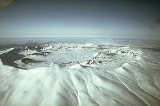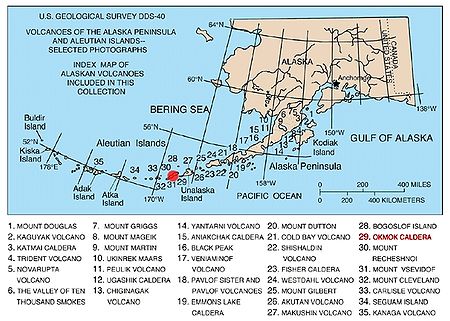
Mount Okmok
Encyclopedia
Mount Okmok is the highest point on the rim of Okmok Caldera (Unmagim Anatuu in Aleut
) on the northeastern part of Umnak Island
in the eastern Aleutian Islands of Alaska
, USA. This 5.8 mile (9.3 km) wide circular caldera
truncates the top of a large shield volcano
. A crater lake
once filled much of the caldera to a depth of over 500 feet (152.4 m), but the lake ultimately drained through a notch eroded in the northeast rim. The prehistoric lake attained a maximum depth of about 150 m (500 ft) and the upper surface reached an elevation of about 475 m (1560 ft), at which point it overtopped the low point of the caldera rim. Small, shallow remnants of the lake remained north of Cone D at an altitude of about 1075 feet: a small shallow lake located between the caldera rim and Cone D; a smaller lake (named Cone B Lake) farther north near the caldera's gate. After the 2008 eruption, the hydrogeology
of the caldera was greatly changed with five separate sizable lakes now emplaced. In addition to the caldera lakes, Cone A, Cone E, Cone G and the new 2008 vent on Cone D contain small crater lakes.
The last major eruptions of Okmok—with an estimated VEI
strength of 6—occurred 8,300 and 2,400 years Before Present
.
Following the formation of the caldera, numerous satellite cones and lava dome
s have formed on the flanks of the volcano. They include Mount Tulik (1253 metres (4,111 ft)), Mount Idak (585 metres (1,919 ft)), and Jag Peak. Mount Tulik erupted in 1936.
The volcano is currently rated by the Alaska Volcano Observatory
as Aviation Alert Level
Green and Volcanic-alert Level
Normal.
 On Saturday, July 12, 2008, Okmok Caldera exploded without warning, sending a plume of ash to 50000 feet (15,240 m) into the air.
On Saturday, July 12, 2008, Okmok Caldera exploded without warning, sending a plume of ash to 50000 feet (15,240 m) into the air.
During the following five and a half days of nearly continuous eruption, residents of Nikolski (47 miles southwest) were stranded for periods of up to three weeks; Unalaska (73 miles northeast) was repeatedly dusted with ash and flights into and out of this major fishing hub were frequently disrupted; floating rafts of scoria and high visibility prompted the Coast Guard to close Umnak Pass to marine traffic; and the Bering Pacific cattle ranch on the flanks of Okmok was periodically evacuated, once during noon-time darkness caused by heavy ash fall. The eruption ended in August 2008. It had a VEI of 4, giving it a rating of "cataclysmic." No lava flow was reported in this eruption, though the volcano has issued flows in the past.
The eruption took place at a new vent in the northeast part of the caldera, creating a roughly 800 ft high cone, dramatically altering caldera hydrology, and discharging huge lahars, or volcanic mudflows, running from the caldera to the coast. In contrast, all 20th century eruptions have been from a cone near the southern rim of the caldera. The 2008 eruption was by far the largest eruption at Okmok since at least the early 13th century.
The volcano also erupted in February 1997 and produced lava
splash and ash clouds to 9000 metres (29,527.6 ft).
Aleut language
Aleut is a language of the Eskimo–Aleut language family. It is the heritage language of the Aleut people living in the Aleutian Islands, Pribilof Islands, and Commander Islands. As of 2007 there were about 150 speakers of Aleut .- Dialects :Aleut is alone with the Eskimo languages in the...
) on the northeastern part of Umnak Island
Umnak
Umnak is one of the Fox Islands of the Aleutian Islands. With of land area, it is the third largest island in the Aleutian archipelago and the 19th largest island in the United States. The island is home to a large volcanic caldera on Mount Okmok and is separated from Unalaska Island by Umnak Pass...
in the eastern Aleutian Islands of Alaska
Alaska
Alaska is the largest state in the United States by area. It is situated in the northwest extremity of the North American continent, with Canada to the east, the Arctic Ocean to the north, and the Pacific Ocean to the west and south, with Russia further west across the Bering Strait...
, USA. This 5.8 mile (9.3 km) wide circular caldera
Caldera
A caldera is a cauldron-like volcanic feature usually formed by the collapse of land following a volcanic eruption, such as the one at Yellowstone National Park in the US. They are sometimes confused with volcanic craters...
truncates the top of a large shield volcano
Shield volcano
A shield volcano is a type of volcano usually built almost entirely of fluid lava flows. They are named for their large size and low profile, resembling a warrior's shield. This is caused by the highly fluid lava they erupt, which travels farther than lava erupted from more explosive volcanoes...
. A crater lake
Crater lake
A crater lake is a lake that forms in a volcanic crater or caldera, such as a maar; less commonly and with lower association to the term a lake may form in an impact crater caused by a meteorite. Sometimes lakes which form inside calderas are called caldera lakes, but often this distinction is not...
once filled much of the caldera to a depth of over 500 feet (152.4 m), but the lake ultimately drained through a notch eroded in the northeast rim. The prehistoric lake attained a maximum depth of about 150 m (500 ft) and the upper surface reached an elevation of about 475 m (1560 ft), at which point it overtopped the low point of the caldera rim. Small, shallow remnants of the lake remained north of Cone D at an altitude of about 1075 feet: a small shallow lake located between the caldera rim and Cone D; a smaller lake (named Cone B Lake) farther north near the caldera's gate. After the 2008 eruption, the hydrogeology
Hydrogeology
Hydrogeology is the area of geology that deals with the distribution and movement of groundwater in the soil and rocks of the Earth's crust, . The term geohydrology is often used interchangeably...
of the caldera was greatly changed with five separate sizable lakes now emplaced. In addition to the caldera lakes, Cone A, Cone E, Cone G and the new 2008 vent on Cone D contain small crater lakes.
The last major eruptions of Okmok—with an estimated VEI
Volcanic Explosivity Index
The Volcanic Explosivity Index was devised by Chris Newhall of the U.S. Geological Survey and Stephen Self at the University of Hawaii in 1982 to provide a relative measure of the explosiveness of volcanic eruptions....
strength of 6—occurred 8,300 and 2,400 years Before Present
Before Present
Before Present years is a time scale used in archaeology, geology, and other scientific disciplines to specify when events in the past occurred. Because the "present" time changes, standard practice is to use AD 1950 as the origin of the age scale, reflecting the fact that radiocarbon...
.
Following the formation of the caldera, numerous satellite cones and lava dome
Lava dome
|250px|thumb|right|Image of the [[rhyolitic]] lava dome of [[Chaitén Volcano]] during its 2008–2009 eruption.In volcanology, a lava dome is a roughly circular mound-shaped protrusion resulting from the slow extrusion of viscous lava from a volcano...
s have formed on the flanks of the volcano. They include Mount Tulik (1253 metres (4,111 ft)), Mount Idak (585 metres (1,919 ft)), and Jag Peak. Mount Tulik erupted in 1936.
The volcano is currently rated by the Alaska Volcano Observatory
Alaska Volcano Observatory
The Alaska Volcano Observatory is a joint program of the United States Geological Survey, the Geophysical Institute of the University of Alaska Fairbanks, and the State of Alaska Division of Geological and Geophysical Surveys...
as Aviation Alert Level
Volcano warning schemes
- USGS Volcano Warning Scheme for the United States :The United States Geological Survey has adopted a common system nationwide for characterizing the level of unrest and eruptive activity at volcanoes...
Green and Volcanic-alert Level
Volcano warning schemes
- USGS Volcano Warning Scheme for the United States :The United States Geological Survey has adopted a common system nationwide for characterizing the level of unrest and eruptive activity at volcanoes...
Normal.
July 2008 eruption

During the following five and a half days of nearly continuous eruption, residents of Nikolski (47 miles southwest) were stranded for periods of up to three weeks; Unalaska (73 miles northeast) was repeatedly dusted with ash and flights into and out of this major fishing hub were frequently disrupted; floating rafts of scoria and high visibility prompted the Coast Guard to close Umnak Pass to marine traffic; and the Bering Pacific cattle ranch on the flanks of Okmok was periodically evacuated, once during noon-time darkness caused by heavy ash fall. The eruption ended in August 2008. It had a VEI of 4, giving it a rating of "cataclysmic." No lava flow was reported in this eruption, though the volcano has issued flows in the past.
The eruption took place at a new vent in the northeast part of the caldera, creating a roughly 800 ft high cone, dramatically altering caldera hydrology, and discharging huge lahars, or volcanic mudflows, running from the caldera to the coast. In contrast, all 20th century eruptions have been from a cone near the southern rim of the caldera. The 2008 eruption was by far the largest eruption at Okmok since at least the early 13th century.
The volcano also erupted in February 1997 and produced lava
Lava
Lava refers both to molten rock expelled by a volcano during an eruption and the resulting rock after solidification and cooling. This molten rock is formed in the interior of some planets, including Earth, and some of their satellites. When first erupted from a volcanic vent, lava is a liquid at...
splash and ash clouds to 9000 metres (29,527.6 ft).
External links
- Volcanoes of the Alaska Peninsula and Aleutian Islands-Selected Photographs
- "Sulfur Dioxide from Okmok Volcano", JPL/NASA image
- Okmok Volcano Ash Cloud Photo page of the Okmok Volcano ash could, July 22, 2008

